Understanding the True Costs of Fire Damage Restoration
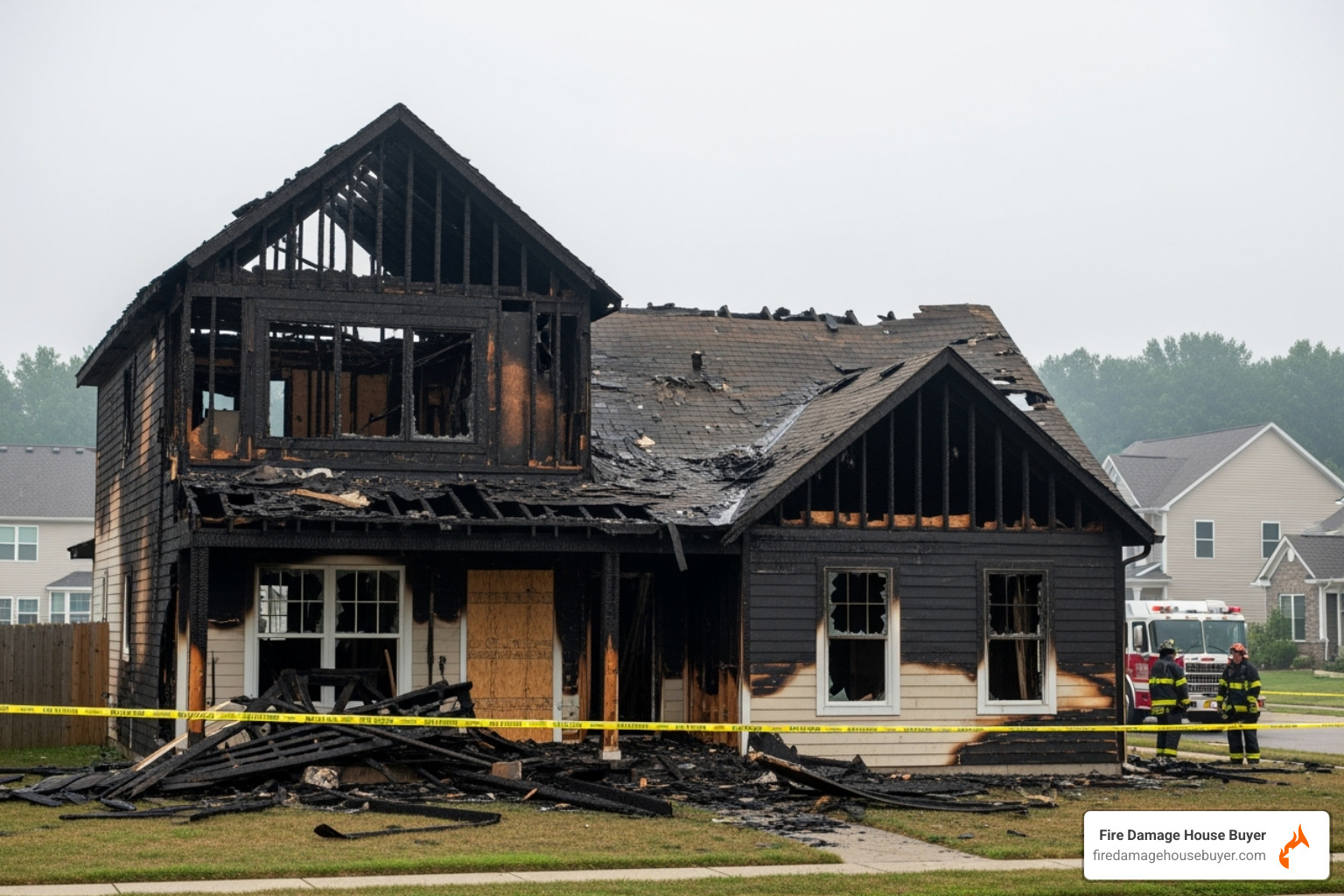
How much does it cost to fix fire damaged house varies dramatically based on the extent of damage, but most homeowners face costs between $8,000 and $180,000. Here’s what you need to know:
Quick Cost Overview:
- Average national cost: $27,258
- Typical range: $3,137 – $51,541
- Per square foot: $4 – $7
- Minor smoke damage: $3,000 – $10,000
- Moderate fire damage: $10,000 – $40,000
- Severe structural damage: $40,000 – $180,000+
The piercing sound of a smoke alarm and the devastating sight of flames consuming your home creates memories that linger long after the fire trucks leave. Beyond the emotional trauma, one of the first challenges you’ll face is understanding the financial reality of restoration.
Fire damage restoration involves much more than what meets the eye. While you might see charred walls and smoke-stained ceilings, there’s often extensive hidden damage from water used to fight the fire, toxic smoke that penetrated deep into materials, and structural issues that aren’t immediately visible. Each type of damage comes with its own restoration process and price tag.
The costs can quickly spiral beyond initial estimates. Water damage from firefighting efforts ranges from $1,000 to $6,000, soot removal costs $2,000 to $6,000, and structural repairs average $4 to $7 per square foot. These numbers don’t include temporary housing, permit fees, or the countless hours you’ll spend managing contractors and insurance claims.
I’m Daniel Cabrera, and over my 15 years buying and selling distressed properties, I’ve helped hundreds of homeowners steer the question of how much does it cost to fix fire damaged house. Through my experience with Fire Damage House Buyer, I’ve seen how restoration costs often exceed expectations, leading many families to choose to Sell Their Fire Damaged House as a simpler path forward.
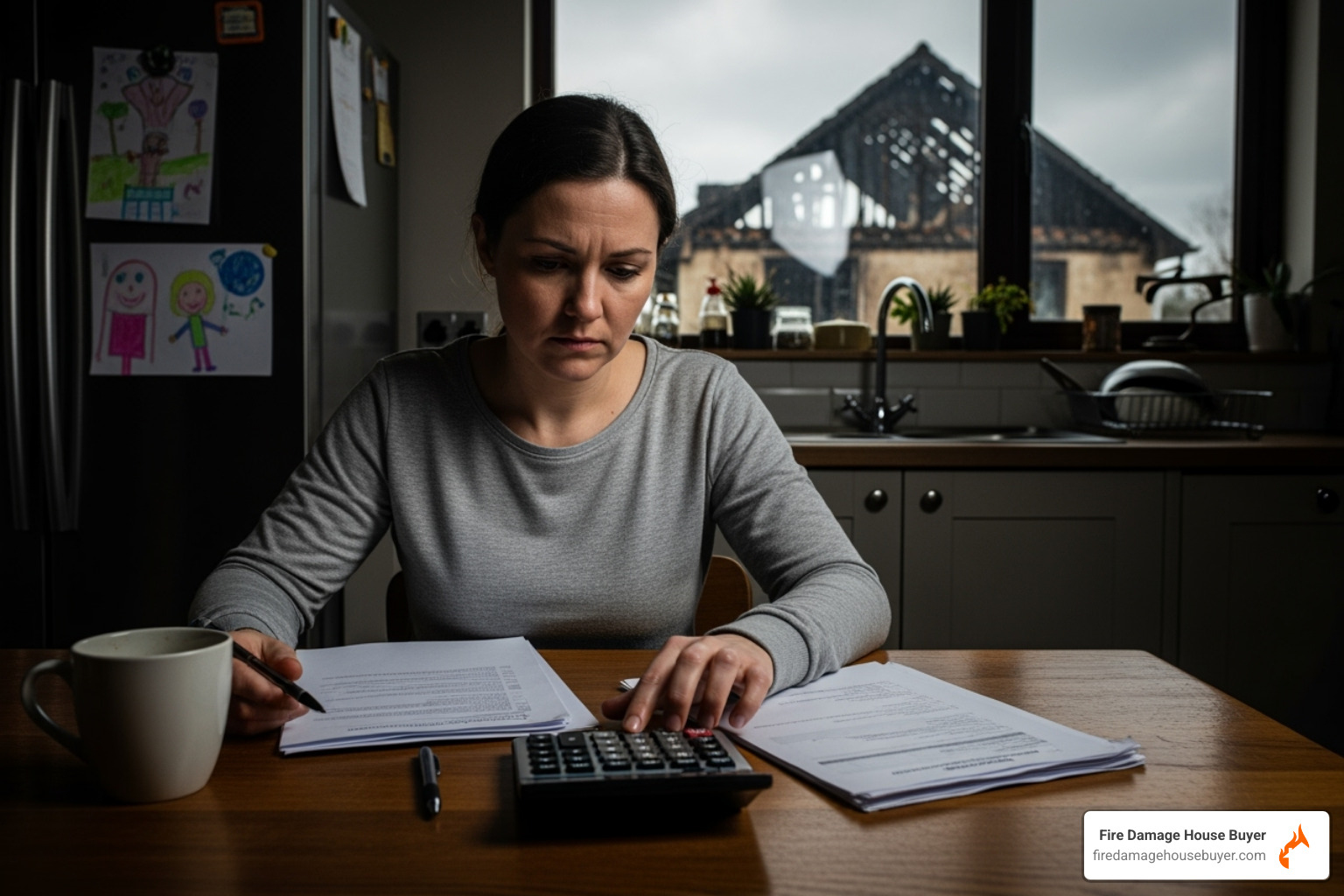
Average Fire Damage Restoration Costs and Key Influencing Factors
When homeowners ask how much does it cost to fix fire damaged house, the answer isn’t simple. The national average sits at $27,258, but this number tells only part of the story. Most families find themselves spending anywhere from $3,137 to $51,541, though severe cases can easily push beyond $180,000.
These wide-ranging costs are shaped by several key factors, including the extent of the damage, your home’s size, the materials involved, and your location.
| Damage Level | Cost Per Square Foot | Typical Total Cost Range |
|---|---|---|
| Basic (Minor) | $4 | $3,000 – $10,000 |
| Standard (Moderate) | $4.70 | $10,000 – $40,000 |
| Complex (Severe) | Up to $7 | $40,000 – $180,000+ |
How much does it cost to fix fire damaged house per square foot?
Fire restoration companies typically charge $4 to $7 per square foot. Minor smoke damage requiring surface cleaning will be on the lower end. However, complex projects involving structural repairs and extensive material replacement push costs toward the higher end or beyond. This per-square-foot cost is a starting point, not a final price.
How does the size of the home impact restoration costs?
Larger homes cost more to restore due to more square footage to clean, more materials to replace, and more labor hours. A 1,000-square-foot home might cost $4,000 to $7,000 for basic work, while a 3,000-square-foot home could be $12,000 to $21,000 for similar damage. Your total bill will be higher for a larger home, even with a potential break on per-square-foot costs.
Regional Differences and Emergency Services Costs
Location significantly impacts restoration costs. The national average of $27,258 is just a baseline; regional differences in labor rates, material costs, and building codes can be shocking. For example, states with stricter building requirements, like California’s seismic and fire-resistant codes, can add thousands to your bill.
Emergency services add immediate costs. After the fire, you’ll need board-up services for broken windows and doors, which can cost several hundred to over a thousand dollars. Water extraction from firefighting efforts typically runs $1,000 to $6,000. Many restoration companies also charge $200 to $500 in emergency response fees for immediate service.
While these emergency steps add to your costs, they’re crucial for preventing further damage and often save money in the long run. Understanding How to Price a Fire Damaged House means factoring in both these urgent expenses and the long-term restoration costs ahead.
Detailed Cost Breakdown by Type of Damage
The total restoration bill is a sum of many parts. Beyond visible flames, you must account for secondary damage from smoke, soot, and water. Each requires specialized techniques, contributing to the answer to how much does it cost to fix fire damaged house.
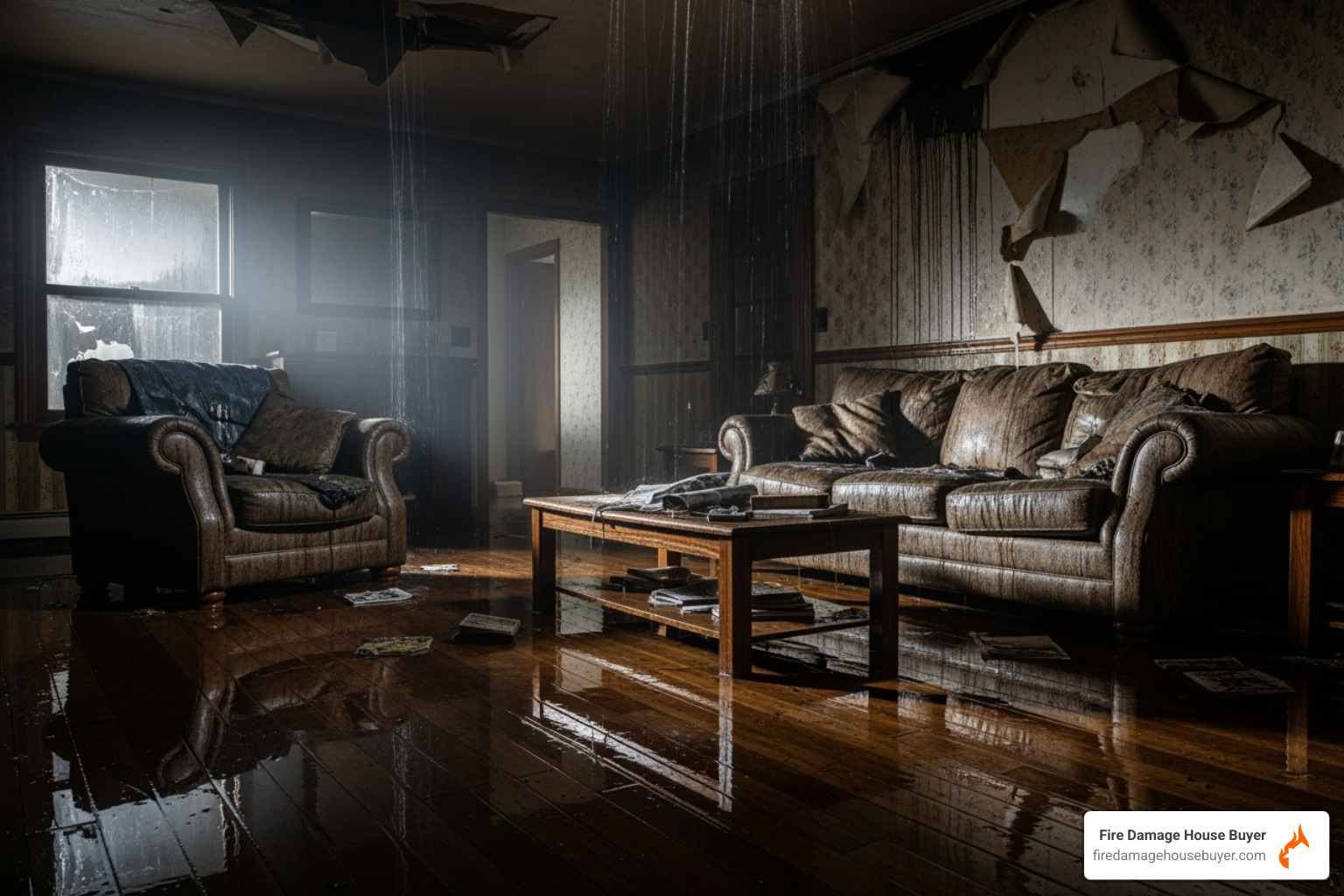
What starts as a fire emergency quickly becomes a water damage crisis, as the water used to save your house creates its own set of problems.
What are the costs for smoke, soot, and water damage?
These three types of damage make restoration more complex and expensive.
- Water damage from firefighting needs immediate attention to prevent mold. Cleanup typically ranges from $1,000 to $6,000.
- Soot removal is crucial as the residue is corrosive. Costs range from $2,000 to $6,000, with oily soot from grease fires being more expensive to clean.
- Smoke damage is insidious, penetrating deep into porous materials. Professional smoke remediation costs $200 to $1,200 per room, with whole-house odor removal costing $1,000 to $3,000.
How much does it cost to repair structural damage?
Structural repairs are often the most expensive part of restoration, as fire weakens the bones of your home. After a mandatory structural inspection ($350 – $900), you could face a variety of costs:
- Foundation repairs: Heat can crack foundations, with repairs ranging from $2,200 to over $20,000 for severe damage.
- Walls and ceilings: Rebuilding a single room can cost $3,000 to $7,000.
- Roof damage: Minor repairs might be under $2,000, but a full replacement often costs $5,900 to $12,800 or more.
- Electrical system: Repairs to melted wiring and damaged circuits typically cost $2,000 to $6,000, but complete rewiring is much more.
- Floor repairs: Costs vary by material, from a few thousand to refinish hardwood to $20,000+ for full replacement.
Cleaning HVAC Systems and Personal Property Replacement
Your HVAC system spreads smoke and soot, requiring professional cleaning for $300 to $1,000. If ductwork needs replacement, costs can rise significantly.
Beyond the structure, replacing personal belongings adds up quickly. Debris removal alone can cost $300 to $1,600. Replacing furniture, appliances, electronics, and clothing for a family can easily add $10,000 to $20,000 or more to the total bill. Even small items like pantry goods and bathroom essentials contribute to the mounting expenses.
The complexity of dealing with these different types of damage is why many homeowners find the process overwhelming. For guidance on what can be saved, check our guide on Cleaning Up After a House Fire.
How Fire Characteristics and Specialized Services Affect Restoration Costs
Not all fires are created equal. The source of the fire changes the cleanup process and the final bill. According to the Fire Equipment, Manufacturers’ Association, fires fall into distinct categories, each requiring a specialized approach that affects how much does it cost to fix fire damaged house.
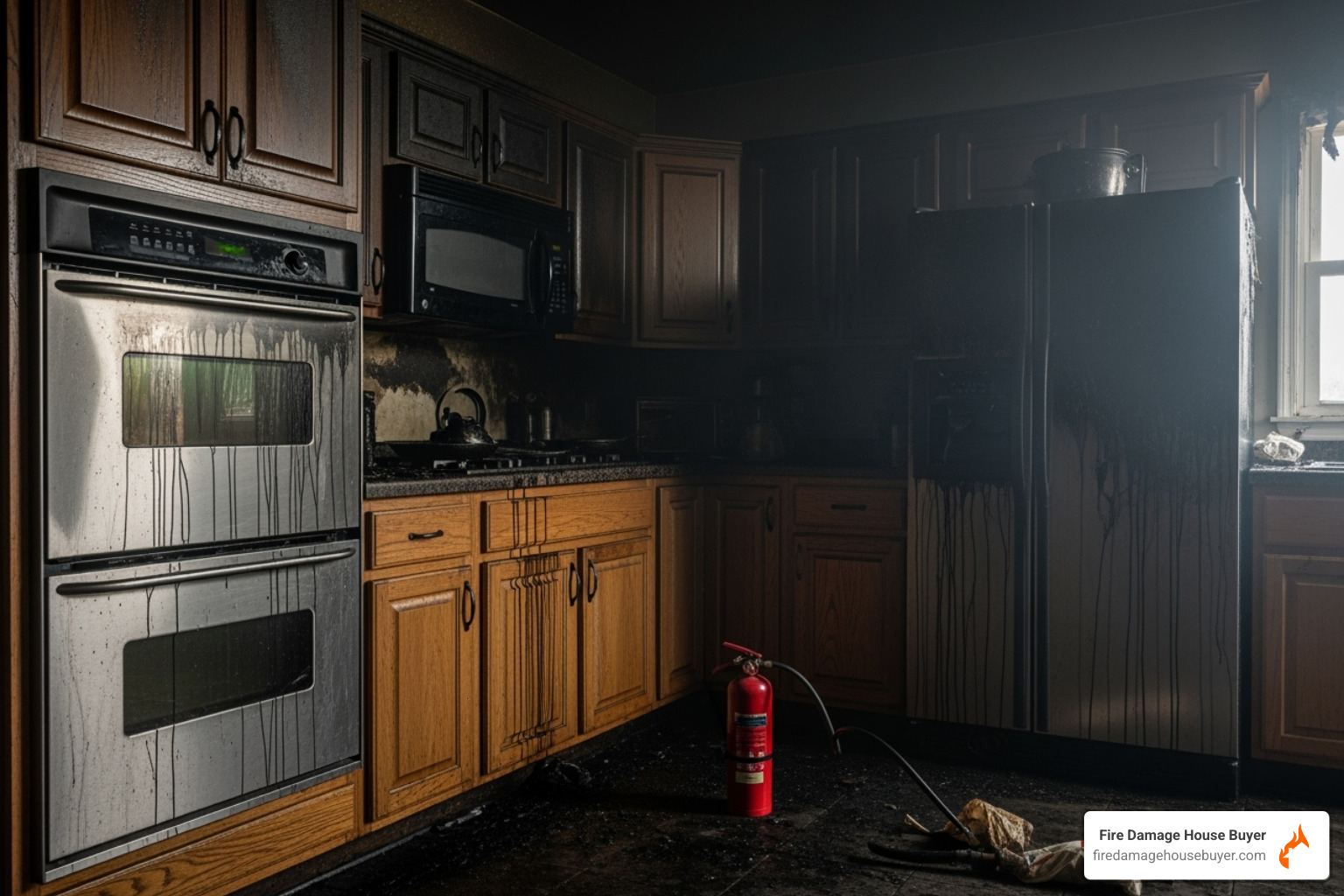
How do different types of fires affect restoration costs?
The fuel that fed your fire creates a unique type of smoke and soot. Here’s what to expect:
- Class A (Wood, Paper, Fabric): These create a dry, powdery ash that is relatively easy to clean. Restoration for moderate damage typically runs $9,000 to $14,000.
- Class K (Kitchen Grease/Oils): These produce an oily, sticky soot that is difficult to remove. A 2010 National Fire Protection Association study found that 41% of home fires start in kitchens. Restoration costs are higher, from $12,000 to $20,000.
- Class C (Electrical): These fires create a fine, corrosive soot and require extensive electrical repairs. Costs range from $12,000 to $23,000.
- Class B (Flammable Liquids): These produce dense, oily smoke similar to kitchen fires, with restoration costs from $14,000 to $20,000.
- Class D (Combustible Metals): Rare in homes, these are the most expensive to address, costing $16,000 to $25,000 due to specialized cleanup procedures.
Specialized Cleaning Services: Thermal Fogging and Ozone Treatment
Lingering smoke odors often require specialized services because microscopic particles embed in porous materials. Regular cleaning can’t reach them.
Thermal fogging uses a heated deodorizing mist to neutralize odors from within materials, costing $200 to $600 per floor. For severe odors, ozone treatment chemically breaks down odor molecules. It is highly effective but requires evacuating the home and costs $300 to $1,000.
These services add to the bill but are often essential to make a home livable again. The complexity of different fire types and the need for specialized treatments can turn a seemingly manageable project into an expensive, months-long ordeal.
The Complexities of Restoration: Insurance, Professionals, and Hidden Expenses
Navigating the restoration process involves more than just repairs; it’s a complex project with logistical and financial problems. Dealing with insurance, hiring contractors, and uncovering hidden costs can turn a difficult situation into a nightmare. As the Department of Industrial Relations notes, toxic gases may be present, making professional intervention critical.
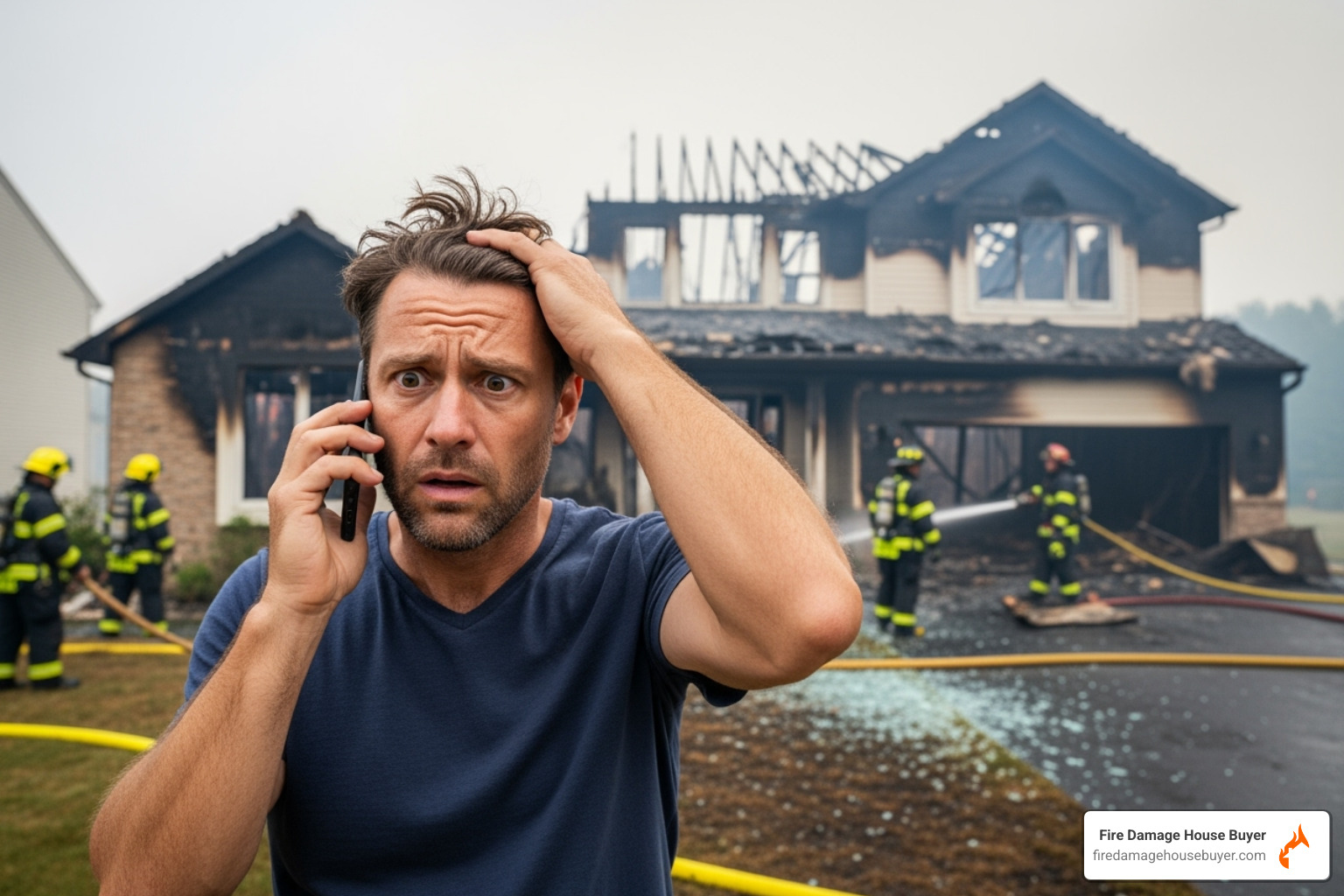
How does insurance work and what are the out-of-pocket costs?
While a standard homeowner’s policy covers fire damage, you’ll still be responsible for a deductible, typically $1,000 to $2,500. This is money that comes straight out of your pocket before your insurance company pays a single dollar toward repairs.
The reality is that costs can also exceed your policy limits, leaving you to pay the difference. If your dwelling coverage is $200,000 but restoration costs hit $250,000, you’re on the hook for that extra $50,000. The claims process itself can be long and arduous, requiring extensive documentation and negotiation with adjusters who may not always have your best interests at heart.
Policy limits become a harsh reality when you find that your personal property coverage might only be 50-70% of your dwelling coverage. Non-covered items like certain types of damage or specialized belongings can add thousands more to your bill. Code upgrades required by local building departments often aren’t fully covered unless you have specific endorsements on your policy.
Beyond the deductible, you’ll face temporary housing costs that can run $1,500 to $3,000 per month while restoration drags on for months. Permit and inspection fees ranging from $100 to $500 or more are necessary but rarely covered. Some homeowners hire a public adjuster who charges 10-15% of your settlement but can often secure significantly higher payouts from insurance companies.
The stress of managing insurance claims while dealing with the trauma of losing your home creates an emotional burden that’s hard to quantify. Many families find themselves caught between what they thought their insurance would cover and the reality of how much does it cost to fix fire damaged house in today’s market.
For additional support during this overwhelming time, refer to Post-Fire Recovery Resources. Health risks are present immediately after a fire, so prioritize safety and avoid entering the home until authorities deem it safe.
Restoration vs. Rebuilding: Is There a Better Way?
When faced with extensive damage, you have to decide whether to restore, rebuild, or consider another path. Rebuilding a house from scratch can cost $100 to over $200 per square foot, often exceeding the cost of restoration but necessary for catastrophic damage. In markets like Toronto and the GTA, rebuilding costs can soar to $200 to $500 per square foot.
Restoration focuses on repairing existing structures and cleaning contaminated materials. It’s typically the preferred option for moderate damage where the structural integrity remains largely intact. However, both options involve months of construction, complex permitting, and significant financial strain.
The average timeline for fire damage repair stretches 1 to 6 months, but severe cases can extend well beyond that. During this time, you’re juggling contractors, inspectors, insurance adjusters, and permit offices while living in temporary housing and watching your savings dwindle.
Both options require you to become a project manager overnight, coordinating multiple trades, ensuring work meets code, and fighting for every dollar from your insurance company. The emotional toll of seeing your home in various states of demolition and reconstruction can be overwhelming.
This is why many homeowners wonder If they can Sell a Fire Damaged House. The answer is yes, and it’s often the simplest solution. When you’re facing the daunting prospect of managing a restoration project that could take months or even years, selling your fire-damaged house as-is eliminates all these complexities.
Many families find that the fastest path forward brings the most peace of mind, allowing them to move on with their lives instead of being trapped in an endless cycle of repairs, inspections, and insurance battles. The decision between Rebuild or Sell After House Fire? often comes down to whether you want to spend the next year of your life managing a construction project or start fresh somewhere new.
Frequently Asked Questions about Fire Damage Restoration Costs
Understanding how much does it cost to fix fire damaged house often leads to more questions about the process, timeline, and long-term implications. After helping countless homeowners steer these challenges, I’ve found these are the questions that come up most often.
How long does fire damage restoration typically take?
The timeline for fire damage restoration is one of those “it depends” answers that I know isn’t very satisfying when you’re eager to get your life back to normal. Minor smoke damage might only take a few days to a couple of weeks – think surface cleaning and basic odor removal.
However, projects involving significant structural repairs tell a very different story. When you’re dealing with extensive water mitigation from firefighting efforts, comprehensive odor removal, and structural rebuilds, you’re looking at several months. I’ve seen projects stretch to 8 months or even longer.
What makes the timeline so unpredictable? Permit approvals can take weeks, especially if your local building department is backlogged. Material availability became a huge issue during recent supply chain disruptions – sometimes waiting months for specific materials. Contractor schedules can be another bottleneck, particularly if you need specialized restoration experts. And don’t forget insurance claim processing, which can add weeks or months to the timeline.
The reality is that while everyone wants things done efficiently, patience becomes essential. Many homeowners find this extended timeline emotionally and financially draining, which is why some choose to Sell Fire Damaged House instead of enduring the lengthy restoration process.
What items can be salvaged after a fire?
This question always breaks my heart a bit because I know how attached people are to their belongings. The salvageability of items depends largely on what they’re made of and how much heat, smoke, and water they were exposed to.
Non-porous items like metal, glass, and hardwood typically have the best chances of recovery. These materials can often be professionally cleaned and restored to their original condition. I’ve seen beautiful hardwood furniture come back to life with the right restoration techniques.
On the flip side, porous materials face an uphill battle. Upholstered furniture, mattresses, clothing, and carpets often become unsalvageable because smoke and soot penetrate deep into the fibers. Even if they look okay on the surface, they can harbor lingering odors and potentially harmful particles that pose health risks.
There’s a middle ground with specialized restoration services. Cherished items like photographs, important documents, and electronics might be salvageable through specialized techniques. However, this comes at a significant cost – typically ranging from $500 to $3,000 for document restoration alone. The question becomes whether the sentimental or practical value justifies the expense.
For safety reasons, certain items should be discarded regardless of their apparent condition. This includes electrical equipment that was exposed to heat or water, burned clothing and textiles, upholstered furniture that absorbed smoke, cosmetics, medicines, and any food items – even if they appear undamaged.
Does fire damage permanently decrease home value?
This is probably the question that keeps homeowners up at night, and I understand why. A fire can significantly impact your property value, at least initially. The good news is that professional restoration can recover much of this value when done properly.
However, there’s a disclosure requirement that can’t be avoided. The fire must be disclosed to future buyers, and this knowledge can deter some potential purchasers. It’s not necessarily rational – a properly restored home can be just as safe and valuable as any other – but buyer psychology is what it is.
The quality of restoration work makes all the difference. If repairs aren’t done to code, if hidden damage isn’t fully addressed, or if smoke odors linger, the value impact can indeed be permanent. Conversely, professional restoration that includes modern updates can sometimes even increase the property’s value beyond its pre-fire condition.
The key factors that determine long-term value impact include the thoroughness of the restoration work, whether all building codes are met or exceeded, the complete elimination of odors, and proper documentation of all work performed. High-quality restoration with modern materials and techniques can actually make your home more valuable than before.
This is why the decision of whether to Rebuild or Sell After House Fire? becomes so critical. It depends on the severity of damage, your financial situation, your timeline needs, and your long-term goals. Sometimes the simplest path forward – selling as-is – provides the most peace of mind and financial certainty.
Skip the Hassle: A Simpler Path Forward
When homeowners ask how much does it cost to fix fire damaged house, they’re often unprepared for the reality that extends far beyond dollar signs. Yes, the financial burden is substantial—with costs ranging from $3,137 to $51,541 for most homes, and severe cases exceeding $180,000. But the emotional and mental toll can be even more devastating.
The restoration process becomes a second disaster all its own. You’re juggling insurance adjusters who seem to speak a different language, contractors who show up late (or don’t show up at all), and permit offices with endless paperwork. Meanwhile, you’re living out of suitcases in temporary housing, watching your savings dwindle as hidden problems emerge and costs spiral beyond initial estimates.
I’ve watched countless families start the restoration journey with hope, only to find themselves exhausted months later, wondering if they’ll ever get their lives back to normal. The uncertainty is crushing—will the contractor finish on time? Will insurance cover that unexpected structural issue? Will the smoke smell ever truly disappear?
There’s a straightforward alternative that many homeowners don’t realize exists until they’re deep in restoration hell.
Fire Damage House Buyer offers a completely different path forward—one that eliminates all the stress, uncertainty, and financial risk. We specialize in buying fire-damaged houses in any condition, which means you can skip the entire restoration nightmare.
When you choose to sell your fire-damaged house as-is for a fair cash offer, you’re choosing simplicity over struggle. No repairs needed. No cleaning crews tramping through your damaged home. No contractors to manage, no permits to secure, and no waiting months for insurance settlements.
We handle all the complexities that come with fire-damaged properties. You get a fair cash offer based on your home’s value, close quickly (often within weeks instead of months), and walk away with the funds you need to start fresh somewhere new. No commissions eat into your proceeds, and you can finally put this chapter behind you.
We operate across the United States, from Alabama to Wyoming, helping families move forward after fire damage. The restoration burden doesn’t have to be yours to carry. Sometimes the smartest financial decision is knowing when to Sell Fire Damaged House and invest your time, energy, and money in a fresh start instead.
Contact us today for a hassle-free solution that puts you back in control of your future.

